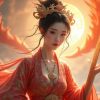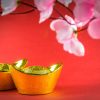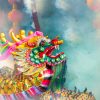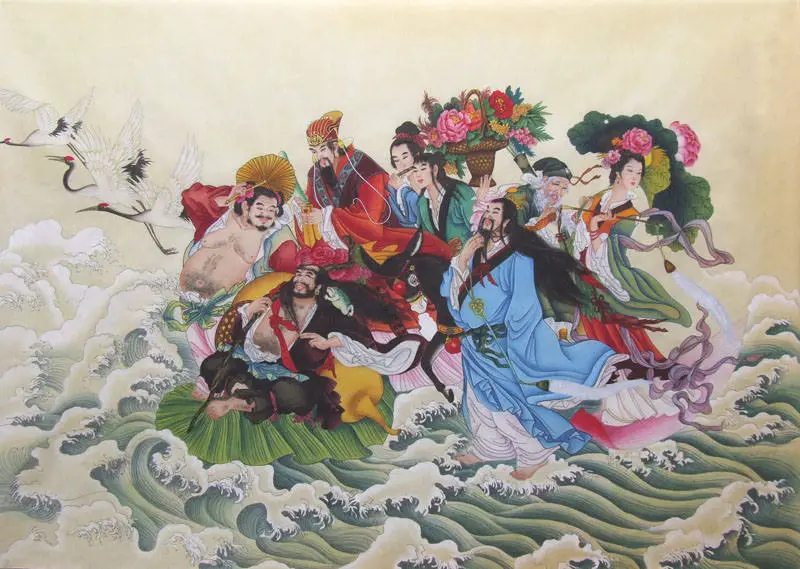
According to Chinese mythology, the Eight Immortals, also known as the Ba Xian (八仙), are a group of mythical heroes from ancient times who battle for righteousness and destroy evil. These characters are a fascinating mix of historical, legendary, and religious figures, each with their own unique background.
The name Bā Xiān is composed of the Chinese characters for “eight,” bā (八), and xiān (仙), which denote “immortal” or “celestial being.” You may also hear them referred to as “the Eight Genies.”
The majority are thought to have been born during the Tang or Song dynasties. They are highly regarded by Taoists and are a common part of secular Chinese culture.
Although they all began as mortal people and are not Gods, they all attained immortality and ascended to Heaven as a result of their pious behavior, integrity, valor, and piety. They are gifted with divine skills and supernatural qualities during the procedure.
These immortals represent every part of Chinese society: women, men, the rich, the poor, the noble, the humble, the old, and the young.
According to legend, the Ba Xian dwelt on Penglai Mountain, which was located on a lovely, paradise-like island in the center of the Bohai Sea. Only the Ba Xian were able to reach the island since the water surrounding it was “weak,” unable to withstand the weight of ships. Despite being shown in art as a group, each of the Eight Immortals had its own stories and myths.
Each Immortal’s strength may be transferred to a power tool, similar to a talisman with a specific significance, that can provide life or vanquish evil. These eight items are collectively known as the “Hidden Eight Immortals” or the “Covert Eight Immortals” (暗八仙). Taoist traditions refer to the Eight as “Roaming Immortals”
The Eight Immortals are most commonly portrayed collectively, but their distinct symbols have been employed to symbolize them at times rather than images of the figures themselves.
The Origin of the Eight Immortals
For a long time, the legends of these immortal creatures have been part of China’s oral history. In the Tang Dynasty, there existed drawings of the Eight Immortals and the story of the Eight Immortals, but the names of the characters had not yet been decided. It wasn’t until the Ming Dynasty (1368–1644), with the publication of Wu Yuantai’s novel “The Emergence of the Eight Immortals and their Travels to the East,” that the eight characters were eventually selected.
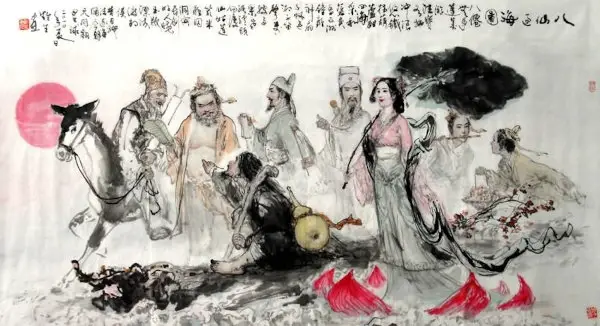
During the Ming Dynasty, stories like “The Eight Immortals Cross the Sea” and “The Banquet of Immortals” were also written by unknown authors about their adventures.
The powers of these immortals are described in detail in these folk tales. These powers include the ability to change into different animals and things, bodies that never get old, the ability to do amazing things, control of Qi, the ability to see the future, and the ability to heal.
Some of the Eight Immortals who are honored in Taoism seem to have lived in the past. They are thought to have been born during the Tang or Song dynasties (618-907 CE) and were recognized by Zhuangzi. While some of the Immortals were historical figures, the magical and mysterious stories surrounding these practitioners make it hard to separate historical from mythological truth.
Each had a very different life: some were generals, one was the father of an empress, and others were scholars, politicians, hermits, artists, and sages.
Taoism’s religious history honors a group of eight xian (immortals) who serve as a tangible representation of the potential to transcend the restrictions of ordinary human existence through Taoist beliefs and activities. They are legendary archetypes of immortality attained through discipline. Despite their status as Daoist deities, the BaXian are held in high regard in secular Chinese society.
Related reading: Caishen – The Chinese God of Wealth and His Role in Chinese Culture and Feng Shui– Opens in new tab
The Powers of the Eight Immortals
Whether you think of the Eight Immortals as historical, semi-historical, or mythical figures, they represent the power that comes with going beyond the limits of normal human life through practices. Their powers include:
- Transformation into many items and beings
- Extraordinary bodies that don’t age and can do amazing physical things
- Controlling individuals, animals, and objects through the manipulation of qi.
- The healing gift
- Predictive ability
Some Taoists may not believe in the actual reality of the Eight Immortals and the forces they symbolize, yet even they can find inspiration, devotion, and even plain enjoyment in these figures. Taoism’s Eight Immortals can be understood psychologically and archetypally, in the same way that figures from other ancient mythology have come to represent human wants and desires on a collective, global level.

The Hidden Eight Immortals
In the same way that these Immortals had their own divine powers, they also used the Hidden Eight Immortals, which were special talismans with their own skills and meanings.
- All evil is subdued by the sword of Lü Dongbin.
- Zhang Guo Lao possessed a drum that could predict the future.
- Han Xiang Zi’s flute could make things grow.
- He Xiangu’s lotus may cultivate people via meditation.
- The jade board of Cao Guo Jiu purified the atmosphere.
- Lan Caihe communicated with the celestial gods through his flower basket.
- Li Tie Guai had gourds that helped people who were sad, helped people who were sick, and helped people who didn’t have much.
- Zhongli Quan’s fan has the power to resurrect the dead.
The Eight Immortals Crossing the Sea
There are a lot of folk stories about them. “The Eight Immortals Crossing the Sea” is the most well-known.
According to the story, a deity calls the Eight Immortals to the “Conference of the Magical Peach” (蟠桃會 pán taó huì). On their journey back, the Dragon King of the East Sea stops them, and both sides get into a heated argument. Finally, the Eight Immortals use their talismans to triumph. They then cross the sea.
Even though there are different versions of the story, one thing remains the same: when the Immortals crossed the ocean, they each showed their own skills by using tools and traits that were unique to them.
This journey inspired the Chinese proverb “Ba xian guo hai, ge xian shen tong” (八仙過海, 各顯神通), which means “The Eight Immortals cross the sea, each revealing their divine powers,” which means that when confronted with a difficult situation, everyone should use their unique skills to achieve a common goal.
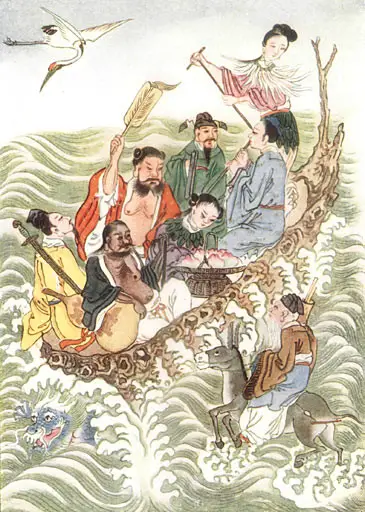
After crossing the sea and arriving at their destination, the Eight Immortals are frequently represented in a garden setting, either with Xi Wangmu or just by themselves, appearing to have just eaten the divine peaches. These are the BaXian’s two most illustrated scenes.
The Eight Immortals have been and will continue to be one of the most common and identifiable subjects in traditional Chinese art. The impact of these legendary people is comparable to that of Greek heroes in Western culture, mythological beings who gained both secular and religious significance via their superhuman deeds and adventures.
Unlike the Greek Heroes, however, depictions of the BaXian on Chinese art have remained to this day, demonstrating the impact of their stories and the significance they have had for ages across East Asia.
Related Reading: “Sanxing” – The Trinity of Luck and Happiness in Chinese Culture and Feng Shui – Opens in new tab
Who are the Eight Immortals?
He Xian Gu (何仙姑) – The only woman in the group
Pinyin: Hé Xiān Gū
Etymology: The name He Xiangu translates as “the Female Celestial Being.”
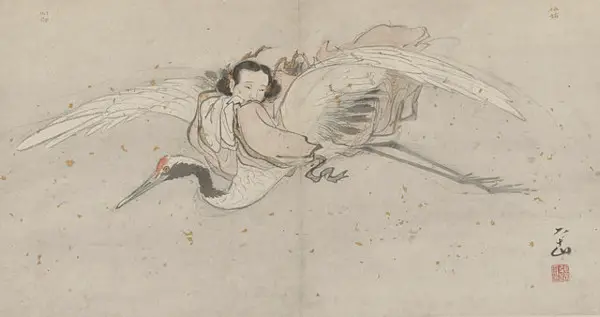
He Xian Gu, the sole woman among the Immortals, is supposed to be the daughter of He Tai, who lives in Zengcheng, Guangdong.
He Xiang Gu was born with exactly six hairs on her head; thus, it was clear from the start that she was unique. At the age of 14, she had a dream in which she was urged to progressively reduce her food intake and to begin consuming powdered mother-of-pearl and moonbeams every day in order to avert death. She swore to stay a virgin while eating it.
An alternative legend claims that He Xian Gu, the daughter of a 7th-century merchant, ate a magical peach and became eternal. She’s been flying around since then.
She is frequently pictured with a lotus flower, which is supposed to promote both mental and physical health. She is sometimes paired with a peach, the divine fruit of the gods associated with immortality, or with a musical instrument or a ladle, both of which are used to dispense wisdom, meditation, and purity.
Cao Guo Jiu (曹國舅) – The Royal Uncle Cao
Pinyin: Cáo Guó Jiù)
Etymology: The name of this immortal translates directly as “Imperial Brother-in-law Cao.”

Considered to be a historical person. Cao Guojiu used to be an official in the Imperial Court. Cao Jingzhi, his younger brother, was also a court official, but he misused his position and was known as a gambler and a corrupt official. Cao Guojie attempted to make up for his brother’s faults by paying off his gambling debts with his own money, but his younger brother was finally convicted with corruption of power. Cao Guojie was so humiliated that he abandoned his political career and fled to the countryside to study Taoism, finally becoming immortal.
According to another story, Cao Gou Jiu was the brother of a 10th-century Song Empress, the uncle of the Song Dynasty’s Emperor, and the son of a military leader.
His castanets are considered to be derived from the pass that provided him with unrestricted access to the palace as a privilege of his status. He is also said to have a jade tablet that can purify the air.
He is depicted in formal court attire, which is always the finest of the Eight Immortals, and recognized as a patron of performers and the theater.
Li Tie Guai (李鐵拐) – The Iron-Crutch Li
Pinyin: Lĭ Tiĕ Guăi
Etymology: The name Li Tieguai translates as “Iron-Crutch Li.”
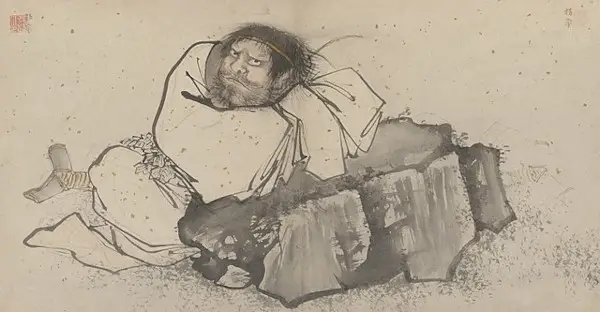
Even though he was one of the more well-known Ba Xian members, Li Tieguai was also one of the most disliked because he was quick to anger. Before he became immortal, Li was a handsome man who studied Taoism with the founder of Taoism, Laozi. Laozi taught Li how to leave his body and travel to heaven. Once, after Li Tie Guai’s spirit had left his body, a student (or perhaps his wife) made the decision that he was dead and burned his body in accordance with custom. When Li Tie Guai’s soul came back from its journey, it was forced to move into the body of a beggar.
He is shown as a crippled beggar holding a double gourd. A cloud emanates from the gourd, which represents longevity and the power to guard against evil. The cloud is a shapeless shape that stands for the soul.
He also carried medication in his gourd that could cure any ailment and offered it to anyone in need. As a result, he was seen as a protector of the poor and sick. Li Tie Guai is sometimes shown riding the qilin.
Lan Caihe (蓝采和) – The Immortal Hermaphrodite
Pinyin: Lán Cǎihé
Etymology: Lan Caihe’s name is a combination of the terms “blue” (藍), “gather” (采), and “gentle” (和).

Lan Caihe is likely a completely mythical character, though some people think otherwise. He has been shown as a young boy, an old man, a woman, and sometimes as a young boy in modern art.
Lan Cai is supposed to have traveled the streets as a beggar, singing a song lamenting the fleeting nature of earthly existence. Lan fled the mortal world one day after being incredibly drunk by riding a crane to heaven.
Her/his special object is a basket of flowers that symbolize long life. She/he carries it to remind people that life is short and that she/he can talk to gods through it.
She/he is dressed in a ragged blue robe with only one shoe. He/she is a determined eccentric, representing a carefree existence free of the anxieties and obligations of everyday life. Lan Cai is the patron god of florists.
Lü Dongbin (呂洞賓) – The Chief leader
Pinyin: Lǚ Dòngbīn
Etymology: Lü Dongbin’s name is composed of three unique characters, “Lǚ” (呂), dòng (洞), which might indicate “hole” or “cave,” and bīn (賓), which means “visitor.”

This is perhaps the most well-known of the Immortals, and he is sometimes regarded as their leader. He is a historical character from the Tang Dynasty, an 8th-century scholar and poet. Zhuang Lin Quan taught Lü Dongbin the mysteries of Taoism. He is honored as a scholar while dressed as one.
The symbol of Lu Dongbin is a magical sword that dispels bad spirits and gives him invisibility. He is revered as a patron deity of highly educated individuals, and others see him as a protector of the medical profession.
He’s got a sword on his back and a fly brush in his hand. Lü Dongbin is also regarded as the patron god of barbers.
He was also linked to “The Yellow Millet Dream,” a culturally significant narrative. According to folklore, Lü Dongbin fell asleep at the stove while cooking millet. In the dream, he had a successful career in the Chinese government, was married, fired, and divorced over a period of 18 years. When he awoke, he felt puzzled and drained. Zhongli Quan gave him the dream to make him comprehend the meaninglessness of material success in life. Lü Dongbin was a god who was very romantic and sexual, but he often got drunk.
Han Xiang Zi (韓湘子) – The Philosopher Han Xiang
Pinyin: Hán Xiāng Zi)
Etymology: The name Han Xiangzi translates as “Han of the Xiang River.”
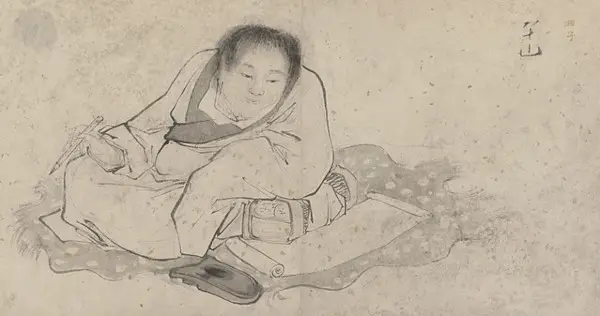
Han Xiang Zi is claimed to be the nephew of Han Yü, a notable 9th-century scholar. Han Yu put Han Xiangzi in a Confucian school to better prepare him for the position of official, but Han Xiangzi was uninterested in his studies. Han Yu put his grandnephew instead in a Buddhist school, but Han Xiangzi still wasn’t interested in what his teacher was teaching.
One day, Han Xiangzi took a peony that was in full bloom and showed his granduncle that he could change the color of flowers. Realizing that Heaven had bestowed extraordinary powers on him, Han Xiangzi returned to his native village, where he met Lü Dongbin and Zhongli Quan, who educated him about Taoism against his grand-uncle’s desires.
His extraordinary abilities included the ability to make flowers grow instantly and to calm wild beasts.His attribute is the flute, which has the ability to create growth. He is depicted as a cheerful man.
Han Xiang Zi is frequently represented with a flute and is revered as the patron deity of musicians.
Related reading: From Celestial Strategist to Guardian of Sexuality: The Evolving Legend of Jiutian Xuannu – Opens in new tab
Zhang Guo Lao (張果老) – The Elder Zhang Guo
Pinyin: Zhāng Guǒ Lǎo)
Etymology: Zhang (張) is a popular Chinese surname, whereas guǒ (果) and lǎo (老) means “fruit” and “old,” respectively.

He is one of the Immortals who can be shown to be a historical character. Zhang Guo Lao lived in the mountains of east-central China as a Taoist monk from the middle of the seventh century until the beginning of the eighth century. During his lifetime, Zhang Guolao was notorious for drinking water from the petals of toxic flowers, snatching birds from the sky with his bare hands, and riding at least a thousand kilometers every day on the back of his beloved white mule. Zhang Guolao died unexpectedly while visiting a temple one day, and his corpse decomposed quickly. However, he was discovered alive and well on a nearby mountain just a few days later.
After years of Taoist study, Zhang Guolao became ill all of a sudden. Despite his extensive understanding of necromancy, he died this time, and his body was discovered in the Zhongtiao Mountains. His followers buried his body, but when they returned to pay their respects a few days later, they discovered his remains had vanished. Zhang Guolao is said to have physically ascended to heaven after his final death.
Zhang Guo Lao’s symbol is a bamboo tube drum with two rods for striking it. The drum can heal lives. He is usually shown sitting on a white mule, looking rearward. He is revered by Taoists as a guardian of youngsters and the elderly, as well as a patron of wine and the good life.
Zhongli Quan (鐘离權) – The Most Ancient of the Eight Immortals
Pinyin: Zhōnglí Quán)
Etymology: The name Zhongli Han is made up of the characters for “concentrate” (鍾), “distance” (離), and “han” (漢). His name translates to “Zhongli of the Han Dynasty.”
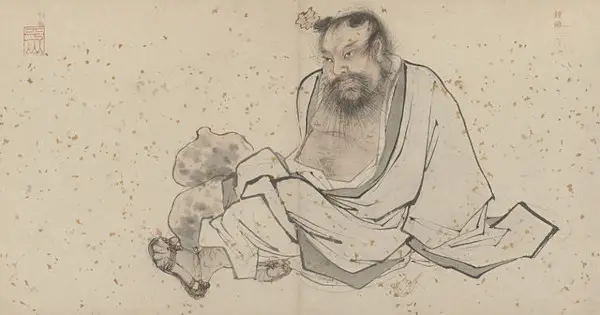
Zhongli Quan, who is most likely simply mythological, is typically shown with his chest and stomach exposed while holding a fan that he can use to raise the dead and turn stones into precious metals. Zhongli Quan, considered one of the eldest of the Ba Xian, erupted from his mother’s body in a shower of dazzling lights with the capacity to talk. He was a notable commander of the Han Dynasty. His military achievements led him to Tibet, where he studied Taoist doctrines and practiced meditation. He ascended to heaven after transforming into a cloud of gold dust during a meditation session.
His symbol is a fan that can resurrect the dead and has the ability to produce silver and gold. He is frequently shown with a lengthy beard that reaches his navel. He’s a charming character who frequently appears with a glass of wine. Zhongli Quan portrays the military guy.
In the next article, we will cover the eight immortals in modern Chinese culture and their usage as Feng Shui symbols. Click here: The Eight Immortals in Chinese Folk Culture and Feng Shui
Online Courses about Chinese Culture from Udemy (Aff.link)
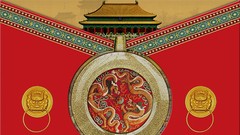
Stay in Touch
 Join our newsletter by using the forms on this website or click here!
Join our newsletter by using the forms on this website or click here! Follow us on Google News
Follow us on Google News Follow us on Facebook
Follow us on Facebook
Featured image from InkDance Chinese Painting Gallery

